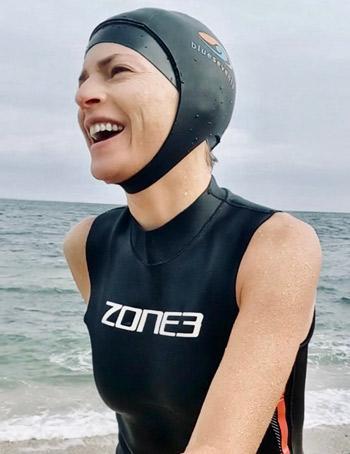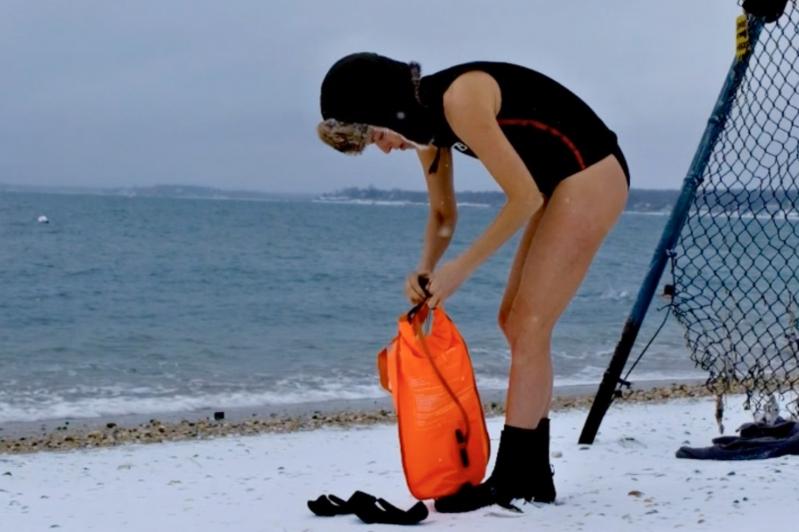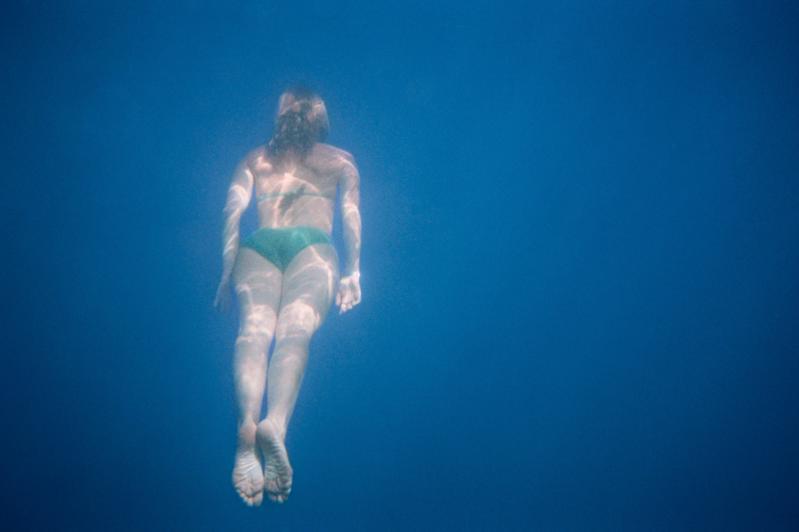It doesn't really start until your heart goes under. Then, comes the shock, the primal awareness that you're a guest in an environment that's anything but welcoming. Immersion in very cold water induces the "cold shock response": a gasp reflex, constriction of blood vessels that causes the skin to prickle and smart as your body desperately tries to conserve heat; your heart rate soars and you start hyperventilating. The physical stress on your body disrupts and alters your thought processes, inducing a flight response that seems impossible to endure.
But, endure, and that's when the magic happens.
For Patricia Garcia-Gomez, a photographer and artist in Orient, taking on the discomfort of the icy water of Long Island Sound while embracing the hushed beauty of winter swimming is when illumination emerges. The joy of being in nature, combined with the perverse euphoria of defying the cold, she said, really does alter her brain.
"I get into the zone of quieting the mind, the zone of tuning in and really listening to the messages your body holds. I believe that in nature and in life there are messages for us everywhere. The world is alive so if you can be in tune with it, you can find creative inspiration, creative ideas, creative solutions. So, going to that space every day is where I go to get into the zone. And oftentimes, if an idea comes to me in the water, I always follow it through because that's the purest form of an intuition drop. So, I have a reverence for my time in the water."

Dafydd Snowdon-Jones
The dark days of Covid-19 sent the practice of wild and cold swimming into overdrive. Social media was awash with posts of swimmers, rosy-cheeked -- mostly women and a few men in every Northern Hemisphere outpost -- looking wild-eyed and euphoric after a midwinter dip. Many described the experience as a balm during difficult times, with its ability to transform the way the body responds to stress. Others likened it to an act of defiance, a chance to feel alive while death stalked the land. Almost all cold-water aficionados were evangelical about the experience being spiritually and psychically cleansing, a panacea for inflammatory diseases, effective in staving off illness, and a conduit to bolster strength, alertness, and vigor.
Ms. Garcia-Gomez's Instagram feed was no different, except that hers was less self-laudatory and more meditative. Each tiny square reflected peacefulness and grace amid an inhospitably gray and sometimes snowy, ice-covered environment. With a tripod set up on the beach, the artist filmed herself each day, usually in slow motion, entering the water for her "tiny baptisms," looking every bit a Bond girl in a neoprene bathing suit and swim cap. Her accompanying captions mostly read like Haiku. "Grateful. Birds, stones, water, sun. Hearing, seeing, feeling, swimming." Her entry into the water was always fluid and calm; it could easily have been the Caribbean but for the lack of turquoise anywhere and her reminder that the air was 42 degrees and the sea 39. Each square was incontrovertibly cold.
Sometimes, her posts were more thought-provoking. "Body over mind. A friend and I were talking about cold-water swimming. She's curious but hesitant. I explain that for me it's important to stay curious and to not name the experience too fast. Just the mention of cold water makes you recoil. But instead you say, 'Oh, I wonder what this feels like.' Find other words for the sensation, then you open a bigger space for a bigger experience. 'Must be mind over matter,' [my friend] said. And it dawned on me, actually, it's the other way around. Body over mind."

Ms. Garcia-Gomez's corporeal relationship to water dates back some 10 years. "I did an underwater series of work that was almost like street photography, but I was underwater capturing scenes," she said. "It began in Italy when I was traveling and then continued in Mexico, Maine, and Australia. Everywhere I went where there was water, I would take my camera. I couldn't always see what I was photographing, but I was really drawn to being in that moment with people." Sometimes, she explained, the water was so cold that she would have to fight to stay under, which she did without the aid of air tanks or flotation devices. Her book, "We Will Swim," showcasing the underwater prints, was published in 2018.
Born and raised in Brownsville, Tex., she began to question her yearning to immerse herself into water's magical, liquid embrace. "What do I think about water? And, why am I drawn to this work?" she asked herself. The answers materialized on the Greek island of Naxos in 2018, during an artist's residency in which she lived in a monastery for three weeks. There, she created a site-specific installation over three floors, each one representing the earth, sky, and water.
On Naxos, she cemented her pledge to swim every day. Her longtime, secondary career as an advertising and branding executive had been upended, she said, after the agency in which she had worked for 10 years, shuttered. Swimming inspired her to literally dive beneath the surface and experience a revelatory exploration of what's needed to care for and repair ourselves when life knocks us down.
"I gave myself a ritual of going to the sea everyday so that I could feel some sense of containment. And, that's where the origins of my swim practice were born. I was growing out of a mindset that was New York City and I was shedding a lot of my own mental patterning. I was going into the water every day and I noticed that my mind was active. The water was giving me a sense of connection to this really live element that was holding and supporting me. And water, by its very nature, is also healing and cleansing. So I noticed that after a while, I had already shifted into a whole other way of being and there was this beautiful, fluid, empty space that I was working within. I started to get really creatively inspired and I was recording water and watching water across the island. I knew then that I didn't want to live in the city anymore."

That fall, after returning to the United States, together with her longtime partner, Dafydd Snowdon-Jones -- a Welshman and fellow cold-water swimmer -- she moved to East Marion. "So I could be closer to the water," she said.
Her posts of her daily immersions soon inspired other curious-but-hesitant swimmers on the East End to reach out and ask if she might help guide them into the wintery waters. She did and yet another creative portal was unlocked in the process. In the spring of 2021, Ms. Garcia-Gomez launched RewildRestore, water-centric retreats on the Greek island of Keros, part of the Small Cyclades.
"My intention is to introduce people to water as a really powerful ally and also to hold space for them so they have a really nourishing and livening experience that brings them into full presence-ing and a connection," she explained, describing that daily activities include swimming, meditation, yoga, breath work, communal meals of farm-fresh food, scheduled excursions, and downtime to pursue whatever is calling. The next retreat will be held in May 2024.
Back on the North Fork, Ms. Garcia-Gomez's wild swimming practice attracted a community of like-minded people who began to meet every Sunday for a dip and banter around a fire pit. Today, the group has grown to around 130 members and is known as the North Fork Polar Bears. This January, they held their inaugural fund-raiser, Splash for CAST, to benefit a nonprofit for low-income individuals and families on the North Fork. The group raised over $50,000 and they'll do it again on Jan. 28, hoping to raise even more.
Last year, J. Crew, the fashion brand, noticed the group's social media page and contacted them. "They reached out to us after seeing the fun we were having, the impact on the community, the 'lifestyle,' and asked to spend the day with us," said Ms. Garcia-Gomez. It resulted in a sort of advertorial spread on the clothing company's website, showcasing an attractive bunch and, naturally, the appropriate merchandise to keep them warm and stave off hypothermia.
For the second year, Ms. Garcia-Gomez will also lead her trademarked Befriending Winter Water retreat at Shou Sugi Ban House, the wellness center in Water Mill. From March 4 through 7 in collaboration with a practitioner of sauna ritual, she'll offer participants cycles of winter water and sauna immersion, guided rituals, and the chance to "perhaps even meet a new version of your fearless self."
So, what happens to this cold-water doyenne during the summer?
"I crave the cold water in the summers, because cold water asks more of you. There's always more effort. No matter how acclimated, you never stop feeling the cold. And, I love that moment where all of a sudden your body calms down and it seems like someone has erased everything that you were thinking and feeling, and you're in this exquisite presence. Everything just feels more alive and richer. And you're in nature, just you in nature, and you feel clean and awake. I still love that the most," she said recently, teeth chattering, her body convulsing, but her face the picture of indescribable joy having only a few minutes earlier overcome the intensity of a cold-water dip on a bone-chilling, gray and windy North Fork day.




